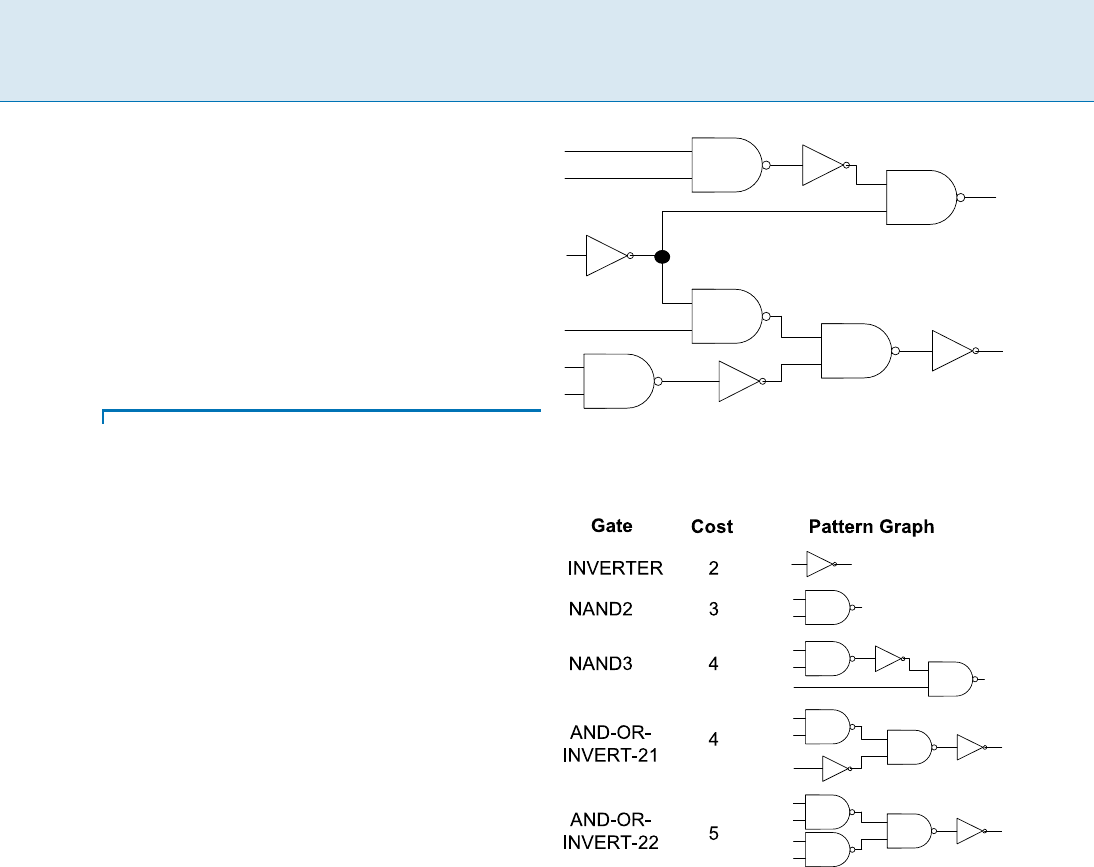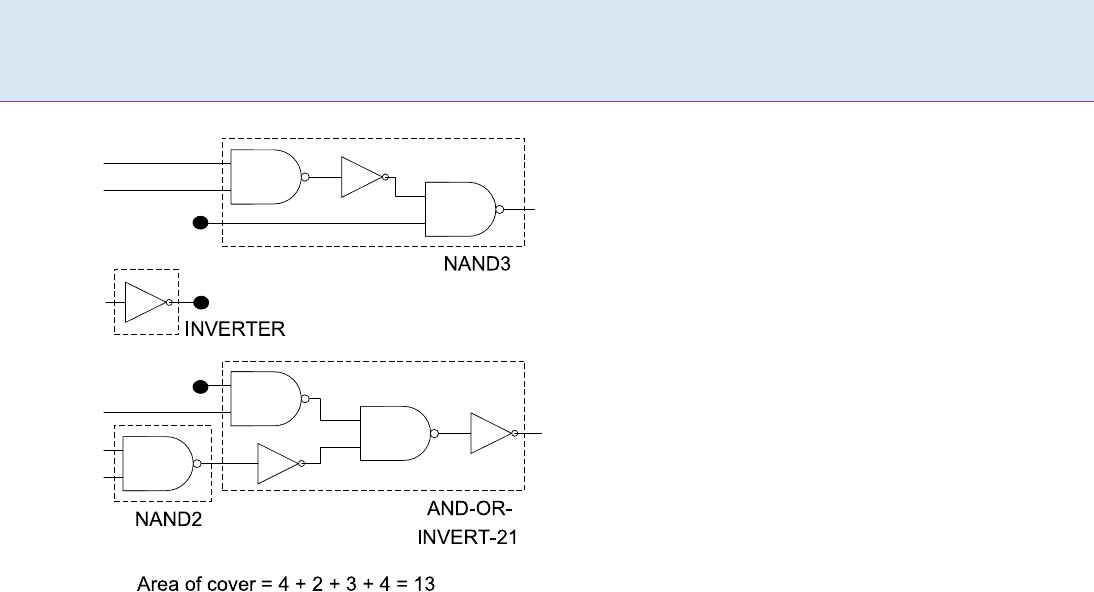Kao M.-Y. (ed.) Encyclopedia of Algorithms
Подождите немного. Документ загружается.


Table Compression T 939
T
Table Compression
2003; Buchsbaum, Fowler, Giancarlo
ADAM L. BUCHSBAUM
1
,RAFFAELE GIANCARLO
2
1
Shannon Laboratory, AT&T Labs, Inc.,
Florham Park, NJ, USA
2
Department of Mathematics and Computer Science,
University of Palermo, Palermo, Italy
Keywords and Synonyms
Compression of multi-dimensional data; Storage, com-
pression and transmission of tables; Compressive esti-
mates of entropy
Problem Definition
Table compression was introduced by Buchsbaum et al. [2]
as a unique application of compression, based on sev-
eral distinguishing characteristics. Tables are collections of
fixed-length records and can grow to be terabytes in size.
They are often generated by information systems and kept
in data warehouses to facilitate ongoing operations. These
data warehouses will typically manage many terabytes of
data online, with significant capital and operational costs.
In addition, the tables must be transmitted to different
parts of an organization, incurring additional costs for
transmission. Typical examples are tables of transaction
activity, like phone calls and credit card usage, which are
stored once but then shipped repeatedly to different parts
of an organization: for fraud detection, billing, operations
support, etc. The goals of table compression are to be fast,
online, and effective: eventual compression ratios of 100:1
or better are desirable. Reductions in required storage and
network bandwidth are obvious benefits.
Tables are different than general databases [2]. Tables
are written once and read many times, while databases
are subject to dynamic updates. Fields in table records
are fixed in length, and records tend to be homogeneous;
database records often contain intermixed fixed- and vari-
able-length fields. Finally, the goals of compression dif-
fer. Database compression stresses index preservation, the
ability to retrieve an arbitrary record, under compres-
sion [6]. Tables are typically not indexed at the level of in-
dividual records; rather, they are scanned in toto by down-
stream applications.
Consider each record in a table to be a row in a matrix.
A naive method of table compression is to compress the
string derived from scanning the table in row-major order.
Buchsbaum et al. [2] observe experimentally that parti-
tioning the table into contiguous intervals of columns and
compressing each interval separately in this fashion can
achieve significant compression improvement. The parti-
tion is generated by a one-time, offline training procedure,
and the resulting compression strategy is applied online
to the table. In their application, tables are generated con-
tinuously, so offline training time can be ignored. They
also observe heuristically that certain rearrangements of
the columns prior to partitioning further improve com-
pression by grouping dependent columns more closely.
For example, in a table of addresses and phone numbers,
the area code can often be predicted by the zip code when
both are defined geographically. In information-theoretic
terms, these dependencies are contexts, which can be used
to predict parts of a table. Analogously to strings, where
knowledge of context facilitates succinct codings of a sym-
bols, the existence of contexts in tables implies, in princi-
ple, the existence of a more succinct representation of the
table.
Two main avenues of research have followed, one
based on the notion of combinatorial dependency [2,3]
and the other on the notion of column dependency [14,
15]. The first formalizes dependencies analogously to
the joint entropy of random variables, while the second
does so analogously to conditional entropy [7]. These ap-
proaches to table compression have deep connections to
universal similarity metrics [11], based on Kolmogorov
complexity and compression, and their later uses in classi-
fication [5]. Both approaches are instances of a new emerg-
ing paradigm for data compression, referred to as boost-

940 T Table Compression
ing [8], where data are reorganized to improve the per-
formance of a given compressor. A software platform to
facilitate the investigation of such invertible data transfor-
mationsisdescribedbyVo[16].
Notations
Let T be a table of n = jTj columns and m rows. Let T[i]
denote the ith column of T. Given two tables T
1
and T
2
,
let T
1
T
2
be the table formed by their juxtaposition. That is,
T = T
1
T
2
is defined so that T[i]=T
1
[i]for1 i jT
1
j
and T[i]=T
2
[i jT
1
j]forjT
1
j < i jT
1
j+ jT
2
j.We
use the shorthand T[i; j] to represent the projection
T[i] T[j]foranyj i. Also, given a sequence P of col-
umn indices, we denote by T[P] the table obtained from T
by projecting the columns with indices in P.
Combinatorial Dependency and Joint Entropy
of Random Variables
Fix a compressor
C:e.g.,gzip,basedonLZ77[17]; com-
press, based on LZ78 [18]; or bzip, based on Burrows–
Wheeler [4]. Let H
C
(T)bethesizeoftheresultofcom-
pressing table T as a string in row-major order using
C.
Let H
C
(T
1
; T
2
)=H
C
(T
1
T
2
):H
C
()isthusacostfunction
defined on the ordered power set of columns. Two ta-
bles T
1
and T
2
, which might be projections of columns
from a common table T,arecombinatorially dependent
if H
C
(T
1
; T
2
) < H
C
(T
1
)+H
C
(T
2
) – if compressing them
together is better than compressing them separately –
and combinatorially independent otherwise. Buchsbaum
et al. [3] show that combinatorial dependency is a com-
pressive estimate of statistical dependency when formal-
ized by the joint entropy of two random variables, i. e., the
statistical relatedness of two objects is measured by the
gain realized by compressing them together rather than
separately. Indeed, combinatorial dependency becomes
statistical dependency when H
C
is replaced by the joint en-
tropy function [7]. Analogous notions starting from Kol-
mogorov complexity are derived by Li et al. [11]andused
for classification and clustering [5]. Figure 1 exemplifies
why rearranging and partitioning columns may improve
compression.
Problem 1 Find a partition
P of T into sets of contiguous
columns that minimizes
P
Y2P
H
C
(Y) over all such parti-
tions.
Problem 2 Find a partition
P of T that minimizes
P
Y2P
H
C
(Y) over all partitions.
The difference between Problems 1 and 2 is that the latter
does not require the parts of
P to be sets of contiguous
columns.
Table Compression, Figure 1
Thefirstthreecolumnsofthetable,takeninrow-majororder,
form a repetitive string that can be very easily compressed.
Therefore, it may be advantageous to compress these columns
separately. If the fifth column is swapped with the fourth, we get
an even longer repetitive string that, again, can be compressed
separately from the other two columns
Column Dependency and Conditional Entropy
of Random Variables
Definition 1 For any table T,adependency relation is
apair(P, c)inwhichP is a sequence of distinct column
indices (possibly empty) and c 62 P is another column in-
dex. If the length of P is less than or equal to k,then(P, c)
is called a k-relation. P is the predictor sequence and c is the
predictee.
Definition 2 Given a dependency relation (P, c), the de-
pendency transform dt
P
(c)ofc is formed by permuting col-
umn T[c] based on the permutation induced by a stable
sort of the rows of P.
Definition 3 A collection D of dependency relations for
table T is said to be a k-transform if and only if: (a)
each column of T appears exactly once as a predictee in
some dependency relation (P, c); (b) the dependency hy-
pergraph G(D) is acyclic; (c) each dependency relation
(P, c)isak-relation.
Let !(P; c) be the cost of the dependency relation (P, c),
and let ı(m) be an upper bound on the cost of comput-
ing !(P; c). Intuitively, !(P; c) gives an estimate of how
well a rearrangement of column c will compress, using the
rows of P as contexts for its symbols. We will provide an
example after the formal definitions.
Problem 3 Find a k-transform D of minimum cost !(D)=
P
(P;c)2D
!(P; c).
Definition 1 extends to columns the notion of context that
is well known for strings. Definition 3 defines a micro-
transformation that reorganizes the column symbols by
grouping together those that have similar contexts. The
context of a column symbol is given by the corresponding
row in T[P].Thefundamentalideasherearethesameas
in the Burrows and Wheeler transform [4]. Finally, Prob-
lem 3 asks for an optimal strategy to reorganize the data
prior to compression. The cost function ! provides an es-

Table Compression T 941
timate of how well c can be compressed using the knowl-
edge of T[P].
Vo and Vo [14] connect these ideas to the conditional
entropy of random variables. Let S be a sequence,
A(S)its
distinct elements, and f
a
the frequency of each element a.
The zeroth-order empirical entropy of S [13]is
H
0
(S)=
1
jSj
X
˛2A(S)
f
a
lg
f
a
jSj
;
and the modified zeroth order empirical entropy [13]is
H
0
(S)=
8
ˆ
<
ˆ
:
0ifjSj =0;
(1 + lg jSj)/jSj if jSj 6=0andH
0
(S)=0;
H
0
(S)otherwise:
For a dependency relation (P, c)withnonemptyP,the
modified conditional empirical entropy of c given P is then
defined as
H
P
(c)=
1
m
X
2A(T[P])
j
c
jH
0
(
c
) ;
where
c
is the string formed by catenating the symbols
in c corresponding to positions of in T[P][14]. A pos-
sible choice of !(P; c) is given by H
P
(c). Vo and Vo also
develop another notion of entropy, called run length en-
tropy, to approximate more effectively the compressibility
of low-entropy columns and define another cost function
! accordingly.
Key Results
Combinatorial Dependency
Problem 1 admits a polynomial-time algorithm, based on
dynamic programming. Using the definition of combina-
torial dependency, one can show:
Theorem 1 ([2]) Let E[i] be the cost of an optimal, con-
tiguous partition of T[1; i]: E[n] is thus the cost of a solu-
tion to Problem 1. Define E[0] = 0;then,for1 i n,
E[i]= min
0j<i
E[j]+H
C
(T
j+1
;:::;T
i
) : (1)
The actual partition with cost E[n] can be maintained by
standard backtracking.
The only known algorithmic solution to Problem 2 is the
trivial one based on enumerating all possible feasible so-
lutions to choose an optimal one. Some efficient heuris-
tics based on asymmetric TSP, however, have been devised
and tested experimentally [3]. Define a weighted, com-
plete, directed graph, G(T), with a vertex T
i
for each col-
umn T[i] 2 T;theweight of edge fT
i
; T
j
g is w(T
i
; T
j
)=
min(H
C
(T
i
; T
j
); H
C
(T
i
)+H
C
(T
j
)). One then generates
a set of tours of various weights by iteratively applying
standard optimizations (e. g., 3-opt, 4-opt). Each tour in-
duces an ordering of the columns, which are then opti-
mally partitioned using the dynamic program (1).
Buchsbaum et al. [3] also provide a general frame-
work for studying the computational complexity of sev-
eral variations of table compression problems based on
notions analogous to combinatorial dependence, and they
give some initial MAX-SNP-hardness results. Particularly
relevant is the set of abstract problems in which one is re-
quired to find an optimal arrangement of a set of strings to
be compressed, which establishes a nontrivial connection
between table compression and the classical shortest com-
mon superstring problem [1]. Giancarlo et al. [10]con-
nect table compression to the Burrows and Wheeler trans-
form [4] by deriving the latter as a solution to an analog of
Problem 2.
Column Dependency
Theorem 2 ([14,15]) For k 2, Problem 3 is NP-hard.
Theorem 3 ([14,15]) An optimum 1-transform for a table
TcanbefoundinO(n
2
ı(m)) time.
Theorem 4 ([14,15]) A 2-transform can be computed in
O(n
2
ı(m)) time.
Theorem 5 ([14]) For any dependency relation (P, c) and
some constant , j
C(dt
P
(c))j5mH
p
(c)+.
Applications
Storage and transmission of alphanumeric tables.
Open Problems
All the techniques discussed use the general paradigms
of context-dependent data rearrangement for compres-
sion boosting. It remains open to apply these paradigms
to other domains, e. g., XML data [9,12], where high-level
structures can be exploited, and to domains where perti-
nent structures are not known a priori.
Experimental Resul t s
Buchsbaum et al. [2] showed that optimal partitioning
alone (no column rearrangement) yielded about 55% bet-
ter compression compared to gzip on telephone usage
data, with small training sets. Buchsbaum et al. [3]exper-
imentally supported the hypothesis that good TSP heuris-
tics can effectively reorder the columns, yielding addi-
tional improvements of 5 to 20% relative to partitioning

942 T Tail Bounds for Occupancy Problems
alone. They extended the data sets used to include other
tables from the telecom domain as well as biological data.
Vo and Vo [14,15] showed further 10 to 35% improve-
ment over these combinatorial dependency methods on
the same data sets.
Data Sets
Some of the data sets used for experimentation are pub-
lic [3].
URL to Code
The pzip package, based on combinatorial dependency, is
available at http://www.research.att.com/~gsf/pzip/pzip.
html. The Vcodex package, related to invertible trans-
forms, is available at http://www.research.att.com/~gsf/
download/ref/vcodex/vcodex.html. Although for the time
being Vcodex does not include procedures to compress
tabular data, it is a useful toolkit for their development.
Cross References
Binary Decision Graph
Burrows–Wheeler Transform
Dictionary-Based Data Compression
Succinct Data Structures for Parentheses Matching
Tree Compression and Indexing
Recommended Reading
1. Blum,A.,Li,M.,Tromp,J.,Yannakakis,M.:Linearapproximation
of shortest superstrings. J. ACM 41, 630–47 (1994)
2. Buchsbaum, A.L., Caldwell, D.F., Church, K.W., Fowler, G.S.,
Muthukrishnan, S.: Engineering the compression of massive
tables: An experimental approach. In: Proc. 11th ACM-SIAM
Symp. on Discrete Algorithms, 2000, pp. 175–84
3. Buchsbaum, A.L., Fowler, G.S., Giancarlo, R.: Improving table
compression with combinatorial optimization. J. ACM 50, 825–
851 (2003)
4. Burrows, M., Wheeler, D.: A block sorting lossless data com-
pression algorithm. Technical Report 124, Digital Equipment
Corporation (1994)
5. Cilibrasi, R., Vitanyi, P.M.B.: Clustering by compression. IEEE
Trans. Inf. Theory 51, 1523–1545 (2005)
6. Cormack, G.: Data compression in a data base system. Com-
mun. ACM 28, 1336–1350 (1985)
7. Cover, T.M., Thomas, J.A.: Elements of Information Theory. Wi-
ley Interscience, New York, USA (1990)
8. Ferragina,P.,Giancarlo,R.,Manzini,G.,Sciortino,M.:Boosting
textual compression in optimal linear time. J. ACM 52, 688–713
(2005)
9. Ferragina, P., Luccio, F., Manzini, G., Muthukrishnan, S.: Struc-
turing Labeled Trees for Optimal Succinctness, and beyond. In:
Proc. 45th Annual IEEE Symposium on Foundations of Com-
puter Science, 2005, pp. 198–207
10. Giancarlo, R., Sciortino, M., Restivo, A.: From first principles to
the Burrows and Wheeler transform and beyond, via combina-
torial optimization. Theor. Comput. Sci. (2007)
11. Li, M., Chen, X., Li, X., Ma, B., Vitanyi, P.M.B.: The similarity met-
ric. IEEE Trans. Inf. Theory 50, 3250–3264 (2004)
12. Liefke, H., Suciu, D.: XMILL: An efficient compressor for XML
data. In: Proceedings of the 2000 ACM SIGMOD Int. Conf.
on Management of Data, pp. 153–164. ACM, New York, USA
(2000)
13. Lifshits, Y., Mozes, S., Weimann, O., Ziv-Ukelson, M.: Speeding
up HMM decoding and training by exploiting sequence repeti-
tions. Algorithmica to appear doi:10.1007/s00453-007-9128-0
14. Manzini, G.: An analysis of the Burrows–Wheeler transform.
J. ACM 48, 407–430 (2001)
15. Vo, B.D., Vo, K.-P.: Compressing table data with column depen-
dency. Theor. Comput. Sci. 387, 273–283 (2007)
16. Vo, B.D., Vo, K.-P.: Using column dependency to compress ta-
bles. In: DCC: Data Compression Conference, pp. 92–101. IEEE
Computer Society TCC, Washington DC, USA (2004)
17. Vo., K.-P.: Compression as data transformation. In: DCC: Data
Compression Conference. IEEE Computer Society TCC, pp. 403.
Washington DCD, USA (2006)
18. Ziv, J., Lempel, A.: A universal algorithm for sequential data
compression. IEEE Trans. Inf. Theory 23, 337–343 (1977)
19. Ziv, J., Lempel, A.: Compression of individual sequences via
variable length coding. IEEE Trans. Inf. Theory 24, 530–536
(1978)
Tail Bounds for Occupancy Problems
1995; Kamath, Motwani, Palem, Spirakis
PAUL SPIRAKIS
Computer Engineering and Informatics, Research
and Academic Computer Technology Institute,
Patras University, Patras, Greece
Keywords and Synonyms
Balls and bins
Problem Definition
Consider a random allocation of m balls to n bins where
each ball is placed in a bin chosen uniformly and indepen-
dently. The properties of the resulting distribution of balls
among bins have been the subject of intensive study in
the probability and statistics literature [3,4]. In computer
science, this process arises naturally in randomized algo-
rithms and probabilistic analysis. Of particular interest is
the occupancy problem where the random variable under
consideration is the number of empty bins.
In this entry a series of bounds are presented (reminis-
cent of the Chernoff bound for binomial distributions) on
the tail of the distribution of the number of empty bins; the
tail bounds are successively tighter, but each new bound

Tail Bounds for Occupancy Problems T 943
has a more complex closed form. Such strong bounds do
not seem to have appeared in the earlier literature.
Key Results
The following notation in presenting sharp bounds on
the tails of distributions. The notation F G will de-
note that F =(1+o(1))G;further,F G will denote that
ln F ln G. The proof that f g, is used for the purposes
of later claiming that 2
f
2
g
. These asymptotic equalities
will be treated like actual equalities and it will be clear that
the results claimed are unaffected by this “approximation”.
Consider now the probabilistic experiment of throw-
ing m balls, independently and uniformly, into n bins.
Definition 1 Let Z be the number of empty bins when m
balls are placed randomly into n bins, and define r = m/n.
Define the function H(m; n; z) as the probability that
Z = z.TheexpectationofZ is given by
= E[Z]=n
1
1
n
m
n e
r
:
Thefollowingthreetheoremsprovidetheboundsonthe
tail of the distribution of the random variable Z. The proof
of the first bound is based on a martingale argument.
Theorem 1 (Occupancy Bound 1) For any >0,
P
jZ j
2exp
2
2
(n
1
2
)
n
2
2
!
:
Remark that for large r this bound is asymptotically equal
to
2exp
2
e
2r
n
1 e
2r
:
The reader may wish to compare this with the following
heuristic estimate of the tail probability assuming that the
distribution of Z is well approximated by the approximat-
ing normal distribution also far out in the tails [3,4].
P
jZ j
2exp
2
e
r
n
2
(
1 (1 + r)e
r
)
:
The next two bounds are in terms of point probabilities
rather than tail probabilities (as was the case in the Bino-
mial Bound), but the unimodality of the distribution im-
plies that the two differ by at most a small (linear) factor.
These more general bounds on the point probability are
essential for the application to the satisfiability problem.
The next result is obtained via a generalization of the Bi-
nomial Bound to the case of dependent Bernoulli trials.
Theorem 2 (Occupancy Bound 2) For >1,
H(m; n; (1 + )) exp
(
(
(1 + )ln[1+]
)
)
:
In particular, for 1 <0,
H(m; n; (1 + )) exp
2
2
:
The last result is proved using ideas from large deviations
theory [7].
Theorem 3 (Occupancy Bound 3) For jz j = ˝(n),
H
(
m; n; z
)
exp
"
n
Z
1
z
n
0
ln
k x
1 x
dx r ln k
!#!
where k is defined implicitly by the equation z = n(1k(1
e
r/k
)).
Applications
Random allocations of balls to bins is a basic model that
arises naturally in many areas in computer science in-
volving choice between a number of resources, such as
communication links in a network of processors, actua-
tor devices in a wireless sensor network, processing units
in a multi-processor parallel machine etc. For such situ-
ations, randomization can be used to “spread” the load
evenly among the resources, an approach particularly use-
ful in a parallel or distributed environment where resource
utilization decisions have to be made locally at a large
number of sites without reference to the global impact
of these decisions. In the process of analyzing the perfor-
mance of such algorithms, of particular interest is the oc-
cupancy problem where the random variable under con-
sideration is the number of empty bins (i. e., machines
with no jobs, routes with no load, etc.). The properties of
the resulting distribution of balls among bins and the cor-
responding tails bounds may help in order to analyze the
performance of such algorithms.
Cross References
Approximation Schemes for Bin Packing
Bin Packing
Recommended Reading
1. Kamath,A.,Motwani,R.,Spirakis,P.,Palem,K.:Tailboundsfor
occupancy and the satisfiability threshold conjecture. J. Ran-
dom Struct. Algorithms 7(1), 59–80 (1995)

944 T Technology Mapping
2. Janson, S.: Large Deviation Inequalities for Sums of Indicator
Variables. Technical Report No. 34, Department of Mathematics,
Uppsala University (1994)
3. Johnson, N.L., Kotz, S.: Urn Models and Their Applications.Wiley,
New York (1977)
4. Kolchin, V.F., Sevastyanov, B.A., Chistyakov, V.P.: Random Allo-
cations. Wiley, New York (1978)
5. Motwani, R., Raghavan, P.: Randomized Algorithms. Cambridge
University Press, New York (1995)
6. Shwartz, A., Weiss, A.: Large Deviations for Performance Analy-
sis. Chapman-Hall, Boca Raton (1994)
7. Weiss, A.: Personal Communication (1993)
Technology Mapping
1987; Keutzer
KURT KEUTZER,KAUSHIK RAVINDRAN
Department of Electrical Engineering and Computer
Science, University of California at Berkeley, Berkeley,
CA, USA
Keywords and Synonyms
Library-based technology mapping; Technology depen-
dent optimization
Problem Definition
Technology mapping is the problem of implementing a se-
quential circuit using the gates of a particular technol-
ogy library. It is an integral component of any automated
VLSI circuit design flow. In the prototypical chip design
flow, combinational logic gates and sequential memory el-
ements are composed to form sequential circuits. These
circuits are subject to various logic optimizations to min-
imize area, delay, power and other performance metrics.
The resulting optimized circuits still consist of primitive
logic functions such as AND and OR gates. The next step
is to efficiently realize these circuits in a specific VLSI tech-
nology using a library of gates available from the semi-
conductor vendor. Such a library would typically consist
of gates of varying sizes and speeds for primitive logic
functions, (AND and OR) and more complex functions
(exclusive-OR, multiplexer). However, a naïve translation
of generic logic elements to gates in the library will fall
short of realistic performance goals. The challenge is to
construct a mapping that maximally utilizes the gates in
the library to implement the logic function of the circuit
and achieve some performance goal—for example, min-
imum area with the critical path delay less than a target
value. This is accomplished by technology mapping.For
the sake of simplicity, in the following discussion it is pre-
sumed that the sequential memory elements are stripped
from the digital circuit and mapped directly into memory
Technology Mapping, Figure 1
Subject graph (DAG) of a Boolean circuit expressed using NAND2
and INVERTER gates
Technology Mapping, Figure 2
Library of pattern graphs (composed of NAND2 and INVERTER
gates) and associated costs
elements of the particular technology. Then, only Boolean
circuits composed of combinational logic gates remain to
be mapped. Further, each remaining Boolean circuit is
necessarily a directed acyclic graph (DAG).
The technology mapping problem can be restated in
a more general graph-theoretic setting: find a minimum
cost covering of the subject graph (Boolean circuit) by choos-
ing from the collection of pattern graphs (gates) available in
a library. The inputs to the problem are:
(a) Subject graph: This is a directed acyclic graph rep-
resentation of a Boolean circuit expressed using a set of
primitive functions (e. g., 2-input NAND gates and invert-
ers). An example subject graph is shown in Fig. 1.
(b) Library of pattern graphs: This is a collection
of gates available in the technology library. The pattern
graphs are also DAGs expressed using the same primitive

Technology Mapping T 945
functions used to construct the subject graph. Addition-
ally, each gate is annotated with a number of values for
different cost functions, such as area, delay, and power.
An example library and associated cost model is shown in
Fig. 2.
A valid cover is a network of pattern graphs imple-
menting the function of the subject graph such that: (a)
every vertex (i.e. gate) of the subject graph is contained
in some pattern graph, and (b) each input required by
a pattern graph is actually an output of some other pat-
tern graph (i. e. the inputs of a gate must exist as outputs
of other gates). Technology mapping can then be viewed
as an optimization problem to find a valid cover of mini-
mumcostofthesubjectgraph.
Key Results
To be viable in a realistic design flow, an algorithm for
minimum cost graph covering for technology mapping
should ideally possess the following characteristics: (a) the
algorithm should be easily adaptable to diverse libraries
and cost models—if the library is expanded or replaced,
the algorithm must be able to utilize the new gates effec-
tively, (b) it should allow detailed cost models to accu-
rately represent the performance of the gates in the library,
and (c) it should be fast and robust on large subject graph
instances and large libraries. One technique for solving
the minimum cost graph covering problem is to formu-
late it as a binate-covering problem, which is a specialized
integer linear program [5]. However, binate covering for
a DAG is NP-Hard for any set of primitive functions and
is typically unwieldy on large circuits. The DAGON al-
gorithm suggested solving the technology mapping prob-
lem through DAG covering and advanced an alternate ap-
proach for DAG covering based on a tree covering approx-
imation that produced near-optimal solutions for practical
circuits and was very fast even for large circuits and large
libraries [4].
DAGON was inspired by prevalent techniques for pat-
tern matching employed in the domain of code genera-
tion for programming language compilers [1]. The funda-
mental concept was to partition the subject graph (DAG)
into a forest of trees and solve the minimum cost covering
problem independently for each tree. The approach was
motivated by the existence of efficient dynamic program-
ming algorithms for optimum tree covering [2]. The three
salient components of the DAGON algorithm are: (a) sub-
ject graph partitioning, (b) pattern matching, and (c) cov-
ering.
(a) Subject graph partitioning: To apply the tree cov-
ering approximation the subject graph is first partitioned
into a forest of trees. One approach is to break the graph at
each vertex which has an out-degree greater than 1 (mul-
tiple fan-out point). The root of each tree is the primary
output of the corresponding sub-circuit and the leaves are
the primary inputs. Other heuristic partitions of the sub-
ject graph that consider duplication of vertices can also be
applied to improve the quality of the final cover. Alternate
subject graph partitions can also be derived starting from
different decompositions of the original Boolean circuit in
terms of the primitive functions.
(b) Pattern matching: The optimum covering of a tree
is determined by generating the complete set of matches
for each vertex in the tree (i. e. the set of pattern graphs
which are candidates for covering a particular vertex) and
then selecting the optimum match from among the candi-
dates. An efficient approach for structural pattern match-
ing is to reduce the tree matching problem to a string
matching problem [2]. Fast string matching algorithms,
such as the Aho–Corasick and the Knuth–Morris–Pratt
algorithms, can then be used to find all strings (pattern
graphs) which match a given vertex in the subject graph
in time proportional to the length of the longest string in
the set of pattern graphs. Alternatively, Boolean match-
ing techniques can be used to find matches based on logic
functions [12]. Boolean matching is slower than structural
string matching, but it can compute matches independent
of the actual local decompositions and under different in-
put permutations.
(c) Covering: The final step is to generate a valid cover
of the subject tree using the pattern graph matches com-
puted at each vertex. Consider the problem of finding
a valid cover of minimum area for the subject tree. Every
pattern graph in the library has an associated area and the
area of a valid cover is the sum of the area of the pattern
graphs in the cover. The key property that makes mini-
mum area tree covering efficient is this: the minimum area
cover of a tree rooted at some vertex v can be computed us-
ing only the minimum area covers of vertices below v.Iffol-
lows that for every pattern graph that matches at vertex
v, the area of the minimum cover containing that match
equals the sum of the area of the corresponding match at
vandthesumoftheareasoftheoptimalcoversofthe
vertices which are inputs to that match. This property en-
ables a dynamic programming algorithm to compute the
minimum area cover of tree rooted at each vertex of the
subject tree. The base case is the minimum area cover of
a leaf (primary input) of subject tree. The area of a match
at a leaf is set to 0. A recursive formulation of this dy-
namic programming concept is summarized in the Algo-
rithm minimum_area_tree_cover shown below. As
an example, the minimum area cover displayed in Fig. 3 is

946 T Technology Mapping
Technology Mapping, Figure 3
Result of a minimum area tree covering of the subject graph in
Fig. 1 using the library of pattern graphs in Fig. 2
a result of applying this algorithm to the tree partitions of
the subject graph from Fig. 1 using the library from Fig. 2.
Given a vertex v in the subject tree, let M(v) denote the
set of candidate matches from the library of pattern graphs
for the sub-tree rooted at v.
Algorithm minimum_area_tree_cover (
Vertex v ) {
// the algorithm minimum_area_tree_cover
// finds an optimal cover of the tree
// rooted at Vertex v
// the algorithm computes best_match(v)
// and areas_of_best_match(v), which
// denote the best pattern graph match
// at v and the associated areas of
// the optimal cover of the tree rooted
// at v respectively
// check if v is a leaf of the tree
if ( v is a leaf) {
area_of_best_match(v) = 0;
best_match(v) = leaf;
return;
}
// compute optimal cover for each input
// of v
foreach ( input of Vertex v ) {
minimum_area_tree_cover( input );
}
// each tree rooted at each input of v is
// now annotated with its optimal cover
// find the optimal cover of the tree
// rooted at Vertex v
area_of_best_match(v) = INFINITY;
best_match(v) = NULL;
foreach ( Match m in the set of matches
M(v) ) {
// compute the area of match m at
// Vertex v
// area_of_match(v,m) denotes the area
// of the cover when Match m is
// selected for v
area_of_match(v,m) = area(m);
foreach input pin v
i
of matche m {
area_of_match (v,m) =
area_of_match(v,m) +
area_of_best_match(v
i
);
}
// update best pattern graph match
// and associated area of the optimal
// cover at Vertex v
if ( area_of_match(v,m) <
area_of_best_match(v) ) {
area_of_best_match(v) =
area_of_match(v,m);
best_match(v) = m;
}
}
}
In this algorithm each vertex in the tree is visited exactly
once. Hence, the complexity of the algorithm is propor-
tional to the number of vertices in the subject tree times
the maximum number of pattern matches at any vertex.
The maximum number of matches is a function of the pat-
tern graph library and is independent of the subject tree
size. As a result, the complexity of computing the mini-
mum cost valid cover of a tree is linear in the size of the
subject tree, and the memory requirements are also lin-
ear in the size of the subject tree. The algorithm computes
the optimum cover when the subject graph is a tree. In the
general case of the subject graph being a DAG, empirical
results have shown that the tree covering approximation
yields industrial-quality results achieving aggressive area
and timing requirements on large real circuit design prob-
lems [11,13].
Applications
Technology mapping is the key link between technology
independent logic synthesis and technology dependent
physical design of VLSI circuits. This motivates the need
for efficient and robust algorithms to implement large
Boolean circuits in a technology library. Early algorithms

Teleportation of Quantum States T 947
for technology mapping were founded on rule-based lo-
cal transformations [3]. DAGON was the first in advanc-
ing an algorithmic foundation in terms of graph transfor-
mations that was practicable in the inner loop of iterative
procedures in the VLSI design flow [4]. From a theoret-
ical standpoint, the graph covering formulation provided
a formal description of the problem and specified optimal-
ity criteria for evaluating solutions. The algorithm was nat-
urally adaptable to diverse libraries and cost models, and
was relatively easy to implement and extend. The concept
of partitioning the subject graph into trees and covering
the trees optimally was effective for varied optimization
objectives such as area, delay, and power. The DAGON
approach has been incorporated in academic (SIS from
the University of California at Berkeley [6]) and industrial
(Synopsys™ Design Compiler) tool offerings for logic syn-
thesis and optimization.
The graph covering formulation has also served as
a starting point for advancements in algorithms for tech-
nology mapping over the last decade. Decisions related to
logic decomposition were integrated in the graph covering
algorithm, which in turn enabled technology independent
logic optimizations in the technology mapping phase [9].
Similarly, heuristics were proposed to impose placement
constraints and make technology mapping more aware of
the physical design and layout of the final circuit [10]. To
combat the problem of high power dissipation in mod-
ern submicron technologies, the graph algorithms were
enhanced to minimize power under area and delay con-
straints [8]. Specializations of these graph algorithms for
technology mapping have found successful application in
design flows for Field Programmable Gate Array (FPGA)
technologies [7]. We recommend the following works for
a comprehensive treatment of algorithms for technology
mapping and a survey of new developments and chal-
lenges in the design of modern VLSI circuits: [11,12,13].
Open Problems
The enduring problem with DAGON-related technology
mappers is handling non-tree pattern graphs that arise
from modeling circuit elements such as multiplexors,
Exclusive-Ors, or memory-elements (e. g. flip-flops) with
associated logic (e. g. scan logic). On the other hand, ap-
proaches that do not use the tree-covering formulation
face challenges in easily representing diverse technology
libraries and in matching the subject graph in a computa-
tionally efficient manner.
Cross References
Sequential Exact String Matching
Recommended Reading
1. Aho, A., Sethi, R., Ullman, J.: Compilers: Principles, Techniques
and Tools. pp. 557–584. Addison Wesley, Boston (1986)
2. Aho, A., Johnson, S.: Optimal Code Generation for Expression
Trees. J. ACM 23(July), 488–501 (1976)
3. Darringer, J.A., Brand, D., Gerbi, J.V., Joyner, W.H., Trevillyan,
L.H.: LSS: Logic Synthesis through Local Transformations. IBM J.
Res. Dev. 25, 272–280 (1981)
4. Keutzer, K.: DAGON: Technology Binding and Local Optimiza-
tions by DAG Matching. In: Proc. of the 24th Design Automa-
tion Conference 28(1), pp. 341–347. Miami Beach, June 1987
5. Rudell, R.: Logic Synthesis for VLSI Design. Ph. D. thesis, Univer-
sity of California at Berkeley, ERL Memo 89/49, April 1989
6. Sentovich, E.M., Singh, K.J., Moon, C., Savoj, H., Brayton, R.K.,
Sangiovanni-Vincentelli, A.: Sequential Circuit Design using
Synthesis and Optimization. In: Proc. of the IEEE International
Conference on Computer Design: VLSI in Computers & Proces-
sors (ICCD), pp. 328–333. Cambridge, October 1992
7. Cong, J., Ding, Y.: An Optimal Technology Mapping Algorithm
for Delay Optimization in Lookup-Table based FPGA Designs.
In: Proc. of the 1992 IEEE/ACM International Conference on
Computer-Aided Design (ICCAD-92) 8(12), pp. 48–53, Novem-
ber 1992
8. Tiwari, V., Ashar, P., Malik, S.: Technology Mapping for Low
Power in Logic Synthesis. Integr. VLSI J. 20(3), 243–268 (1996)
9. Lehman, E., Watanabe, Y., Grodstein, J., Harkness, H.: Logic
Decomposition during Technology Mapping. IEEE Trans.
Comput.-Aided Des. Integr. Circuits Syst. 16(8), 813–834,
(1997)
10. Kutzschebauch, T., Stok, L.: Congestion Aware Layout Driven
Logic Synthesis. In: Proc. of the IEEE/ACM International Confer-
ence on Computer-Aided Design, 2001, pp. 216–223
11. Devadas, S., Ghosh, A., Keutzer, K.: Logic Synthesis. McGraw
Hill, New York (1994). pp. 185–200
12. De Micheli, G.: Synthesis and Optimization of Digital Circuits,
1st edn., pp. 504–533. McGraw-Hill, New York (1994)
13. Stok, L., Tiwari, V.: Technology Mapping. In: Hassoun, S., Sasou,
T. (eds.) Logic Synthesis and Verification, pp. 115–139. Kluwer
International Series In Engineering And Coputer Science Se-
ries. Kluwer Academic Publisher, Norwell (2002)
Teleportation of Quantum States
1993; Bennett, Brassard, Crepeau, Jozsa, Peres,
Wootters
RAHUL JAIN
Computer Science and Institute for Quantum
Computing, University of Waterloo,
Waterloo, ON, Canada
Keywords and Synonyms
Quantum teleportation; Teleportation
